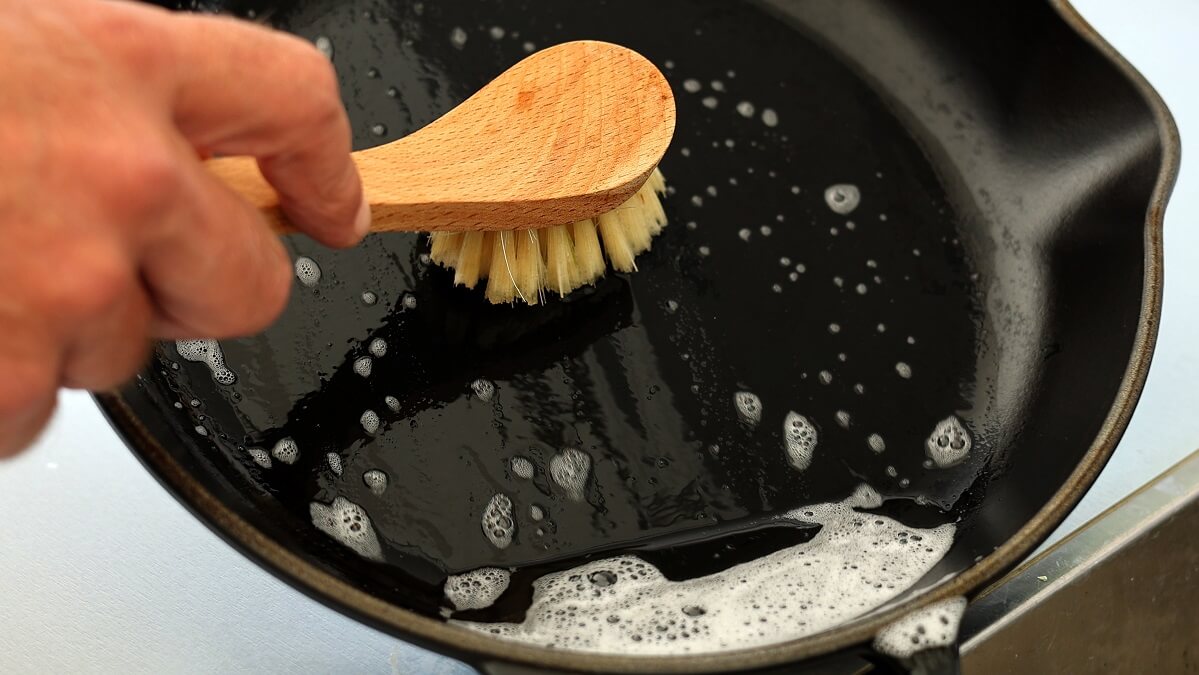I love cooking with cast iron; it’s durable, efficient, endlessly useful and makes for pretty food photos.
A cast iron pan is often referred to as the workhorse of the kitchen, and it is. But there are some things you need to do to keep it in good nick.
Why cook with cast iron?
The benefit of using a cast iron pan is that it gets exceedingly hot and stays that way. Unlike thinner pans made from materials such as aluminium, the heat doesn’t fluctuate. This makes it the perfect option for foods that need a consistent high heat.
They are the ideal choice when it comes to food that needs a hard sear but shouldn’t be scorched, such as steak or roasts that need to be browned before going in the oven.
The surface of the meat takes on a deep brown colour and delicious crust without burning. Plus, cast iron is oven safe so can go straight from stovetop to oven.
Well-seasoned cast iron cookware provides one of the best surfaces for cooking, but it shouldn’t be washed completely clean.
So, how exactly are you supposed to remove the oil, grease and leftover food without popping it in the dishwasher?
How to clean cast iron
It can be intimidating but it’s still a piece of cookware. You wash it, you dry it, you put it away. The main thing is to ensure you don’t do anything to scratch the coating or promote rust.
What you’ll need:
- nonabrasive scrubber or sponge
- clean towel
- dish soap (if needed)
- coarse salt (if needed)
- food-grade oil or fat that has a neutral flavour such as flaxseed oil, canola oil, or lard (if needed).
Method
After cooking, take the pan off the heat and remove any leftover food. Wipe the still-warm surface with paper towels or a cloth to absorb any oil and let it cool slightly before bringing it to the sink.
Rinse the pan with hot water and use a sponge to gently clean the surface, it’s okay to add a little dish soap here if necessary. If you have any tough, caked-on food, adding some coarse salt can help.
Do not scrub the pan with anything too abrasive such as steel wool or a scouring pad as they can damage the coating.
Instead, use a scrubber specifically designed for cast iron or something soft such as a sponge.
Rinse the pan thoroughly to remove any grease, soap and salt.
Then, wipe it down using a dish towel, or pop it back onto a stovetop burner or in a warm, 170 degrees C oven for a few minutes until completely dry.
Important tip: do not leave cast iron out to air dry, as it will rust.
If you do not cook with much oil, after the pan is dry you can add 1/2 teaspoon of oil and use a paper towel to lightly coat the interior surface. Continue to wipe until the surface looks dark and shiny and no oil residue remains.
This will help it maintain its sheen over time. However, if you’re already cooking with oil, it should be well-seasoned, and this step won’t be necessary.
Seasoning cast iron
If you notice that your pan has any rusty or dull spots, you’ll need to re-season it.
What you’ll need:
- paper towel or cloth
- food-grade oil or fat that has a neutral flavour such as flaxseed oil, canola oil, or lard
- oven.
Method
Start with a clean, dry cast iron pan and use a paper towel or cloth to rub two tablespoons of food-grade, neutral oil in a thin layer over the inside and outside of your pan. Use one that has a high smoke point, as your cast iron will be going into a hot oven.
Next, wipe out excess oil and put the pan upside down in a 260°C oven, with a baking sheet underneath to catch any oil drips.
Leave it in the oven for one hour and remember to let it cool before handling it.
The oil should polymerise and harden in the oven, forming an all-natural non-stick coating.
When to season
If you buy an untreated cast-iron pan, you’ll want to season it when you get it home to seal it off before cooking with it. After that, you shouldn’t need to season it unless you notice that it’s getting rusty or dull.
A seasoned pan will look glossy, shiny, and smooth, like well-conditioned leather.
Enamelled cast iron pans
Enamelled cast iron has been pre-treated with a glaze so it doesn’t need to be seasoned. You can also pop it in the dishwasher, but it won’t stand up to high heat as well as traditional cast iron.
How to store cast iron
Cast iron pans can be stacked and stored along with your other cookware. They can also be left out on the stove without being damaged.
Cast iron pans have a reputation for being hard to maintain, but once you have a baseline understanding of how this durable, sustainable material works, you’ll be ready to cook with it again and again.
Do you have a cast iron pan? How often do you cook with it? Share your favourite thing about cast iron in the comments section below.
Also read: Cheap versus expensive frypans

